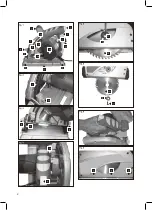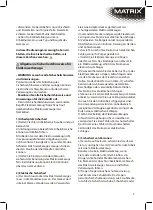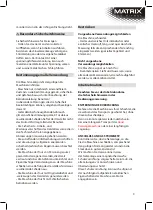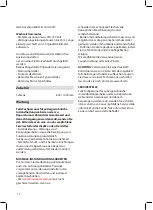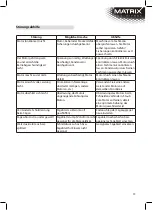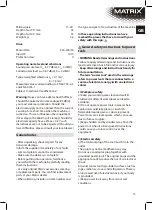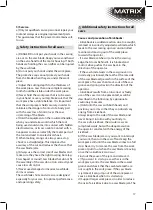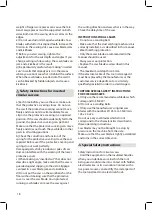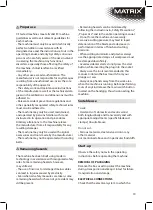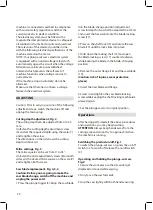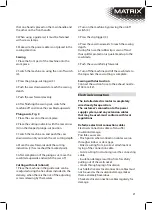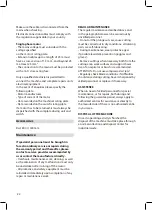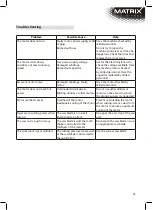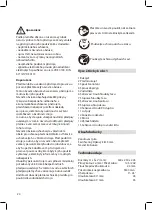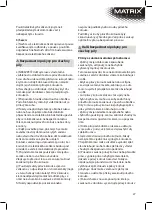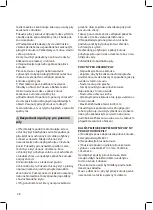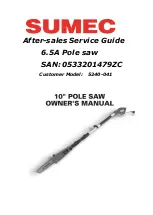
16
Penetration of water into the power tool
increases the risk of electrical shock.
d) Do not use the cable for any purpose other
than that for which it was made. Do not use it
to carry the tool, hang it up, or to pull the plug
out of the outlet. Keep the cable away from heat,
oil, sharp corners or parts of the equipment that
move. Damaged or entangled cords increase the
risk of electrical shock.
e) When operating the power tool outdoors, only
use extension cords that are suitable for outdoor
use. The use of an appropriate extension cord
reduces the risk of an electrical shock.
f) If the power tool must be used in a damp
environment, use a residual current protective
device. The use of such a device reduces the risk
of electrical shock.
3) Personal safety
a) Be attentive, watch what you are doing and
use the power tool sensibly. Do not use power
tools when you are tired or under the influence
of drugs, alcohol or medicines.
One moment of inattention while using a power
tool can result in serious injury.
b) Wear personal protective equipment and
always wear protective glasses. Wearing personal
protective equipment, such as a dust mask, slip-
free safety shoes, protective headwear or ear
protection, depending on the type and use of a
power tool reduces the risk of injury.
c) Avoid unintentional start-ups. Make sure that
the power tool is shut off before it is connected
to the power supply, or is carried. If you have your
finger on the switch of the tool while carrying
it, or have the tool turned on, or connected
to a power supply, this behaviour can lead to
accidents.
d) Remove the adjustment aides or the spanners
before turning on the power tool. A tool or
wrench that is located in a rotating part of the
machine, can lead to injuries.
e) Avoid abnormal posture. Make sure that the
operator is standing firmly and can maintain
balance. This allows the operator to maintain
control over the power tool in unexpected
situations.
f) Wear appropriate clothing. Do not wear
loose clothing or jewellery. Keep hair, clothing
and gloves away from the moving parts. Loose
clothing, jewellery or long hair can get caught in
the moving parts.
g) If dust vacuums or catching systems can be
installed on the tool, make sure that these are
correctly connected and assembled. The use of a
dust exhaust unit can reduce hazards caused by
dust.
4) Use and treatment of the power tool
a) Do not overtax the tool. Use the appropriate
tool for the work that is to be done. With the
correct power tool, you can work better and
more safely.
b) Do not use a power tool where the switch is
defective.
A power tool that cannot be turned on and off is
dangerous and must be repaired.
c) Disconnect the plug from the wall outlet
before you make adjustments to the tool, change
parts or put the tool away. This precaution
prevents inadvertent startups of the tool.
d) Store power tools that are not in use out of
reach of children. Do not let anyone use the tool
who does not have experience with it, or who has
not read these instructions.
Power tools can be dangerous when they are
used by inexperienced people.
e) Take good care of your power tools. Make
sure that movable parts function properly and
do not jam, see that parts which influence the
use of the machine are not broken or damaged.
Repair damaged parts before operating the tool.
Many accidents are caused by poorly maintained
power tools.
f) Keep cutting edges sharp and clean. Properly
maintained cutting tools with sharp cutting
edges jam less often and are easier to control.
g) Use power tools, accessories, and equipment
according to these instructions. Taking into
account the working conditions and the work
being performed.
The use of power tools other than those
intended for the tool itself can lead to dangerous
situations.
Summary of Contents for PS 1000-45
Page 2: ...2...

